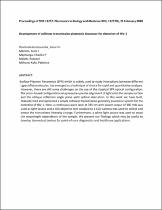 ResearchSpace
ResearchSpace
Development of collinear transmission plasmonic biosensor for detection of HIV-1
JavaScript is disabled for your browser. Some features of this site may not work without it.
- ResearchSpace
- →
- Research Publications/Outputs
- →
- Conference Publications
- →
- View Item
| dc.contributor.author |
Ombinda-Lemboumba, Saturnin

|
|
| dc.contributor.author |
Manoto, Sello L

|
|
| dc.contributor.author |
Maphanga, Charles P

|
|
| dc.contributor.author |
Malabi, Rudzani

|
|
| dc.contributor.author |
Mthunzi-Kufa, Patience

|
|
| dc.date.accessioned | 2020-06-03T10:48:00Z | |
| dc.date.available | 2020-06-03T10:48:00Z | |
| dc.date.issued | 2020-02 | |
| dc.identifier.citation | Ombinda-Lemboumba, S. et al. 2020. Development of collinear transmission plasmonic biosensor for detection of HIV-1. Proceedings of SPIE 11257, Plasmonics in Biology and Medicine XVII, 112570L, 21 February 2020 | en_US |
| dc.identifier.isbn | 9781510632776 | |
| dc.identifier.isbn | 9781510632783 | |
| dc.identifier.issn | 1605-7422 | |
| dc.identifier.issn | 2410-9045 | |
| dc.identifier.uri | https://doi.org/10.1117/12.2546496 | |
| dc.identifier.uri | http://hdl.handle.net/10204/11443 | |
| dc.description | Copyright: 2020 SPIE. Due to copyright restrictions, the attached PDF file only contains the abstract of the full text item. For access to the full text item, please consult the publisher's website: https://doi.org/10.1117/12.2546496 | en_US |
| dc.description.abstract | Surface Plasmon Resonance (SPR) which is widely used to study interactions between different types of biomolecules, has emerged as a technique of choice for rapid and quantitative analyses. However, there are still some challenges on the use of the classical SPR optical configuration. The prism-based configuration setup requires precise alignment of light onto the sample surface and the oblique reflection angle plane yield optical aberration. In this work we have built, characterized and optimized a simple collinear transmission geometry plasmonic system for the detection of HIV-1. Here, a continuous wave laser at 785 nm with power output of 300 mW was used as light source and a 40X objective lens coupled to a CCD camera was used to collect and detect the transmitted intensity change. Furthermore, a white light source was used to study the wavelength dependency of the sample. We present our findings which may be useful to develop biomedical devices for point-of-care diagnostics and healthcare applications. | en_US |
| dc.language.iso | en | en_US |
| dc.publisher | SPIE | en_US |
| dc.relation.ispartofseries | Worklist;23525 | |
| dc.subject | Surface Plasmon resonance | en_US |
| dc.subject | SPR | en_US |
| dc.subject | HIV-1 | en_US |
| dc.subject | Transmission | en_US |
| dc.subject | Biosensors | en_US |
| dc.title | Development of collinear transmission plasmonic biosensor for detection of HIV-1 | en_US |
| dc.type | Conference Presentation | en_US |
| dc.identifier.apacitation | Ombinda-Lemboumba, S., Manoto, S. L., Maphanga, C. P., Malabi, R., & Mthunzi-Kufa, P. (2020). Development of collinear transmission plasmonic biosensor for detection of HIV-1. SPIE. http://hdl.handle.net/10204/11443 | en_ZA |
| dc.identifier.chicagocitation | Ombinda-Lemboumba, Saturnin, Sello L Manoto, Charles P Maphanga, Rudzani Malabi, and Patience Mthunzi-Kufa. "Development of collinear transmission plasmonic biosensor for detection of HIV-1." (2020): http://hdl.handle.net/10204/11443 | en_ZA |
| dc.identifier.vancouvercitation | Ombinda-Lemboumba S, Manoto SL, Maphanga CP, Malabi R, Mthunzi-Kufa P, Development of collinear transmission plasmonic biosensor for detection of HIV-1; SPIE; 2020. http://hdl.handle.net/10204/11443 . | en_ZA |
| dc.identifier.ris | TY - Conference Presentation AU - Ombinda-Lemboumba, Saturnin AU - Manoto, Sello L AU - Maphanga, Charles P AU - Malabi, Rudzani AU - Mthunzi-Kufa, Patience AB - Surface Plasmon Resonance (SPR) which is widely used to study interactions between different types of biomolecules, has emerged as a technique of choice for rapid and quantitative analyses. However, there are still some challenges on the use of the classical SPR optical configuration. The prism-based configuration setup requires precise alignment of light onto the sample surface and the oblique reflection angle plane yield optical aberration. In this work we have built, characterized and optimized a simple collinear transmission geometry plasmonic system for the detection of HIV-1. Here, a continuous wave laser at 785 nm with power output of 300 mW was used as light source and a 40X objective lens coupled to a CCD camera was used to collect and detect the transmitted intensity change. Furthermore, a white light source was used to study the wavelength dependency of the sample. We present our findings which may be useful to develop biomedical devices for point-of-care diagnostics and healthcare applications. DA - 2020-02 DB - ResearchSpace DP - CSIR KW - Surface Plasmon resonance KW - SPR KW - HIV-1 KW - Transmission KW - Biosensors LK - https://researchspace.csir.co.za PY - 2020 SM - 9781510632776 SM - 9781510632783 SM - 1605-7422 SM - 2410-9045 T1 - Development of collinear transmission plasmonic biosensor for detection of HIV-1 TI - Development of collinear transmission plasmonic biosensor for detection of HIV-1 UR - http://hdl.handle.net/10204/11443 ER - | en_ZA |





